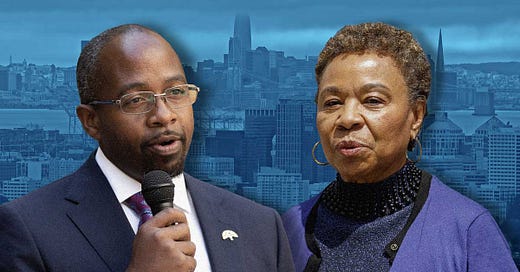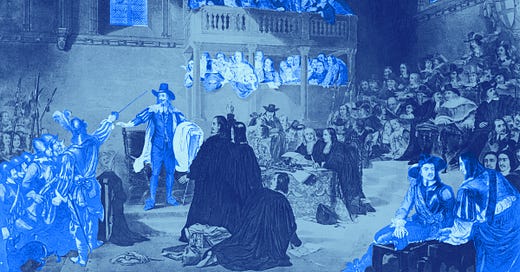
The Free Press

To our veteran subscribers—and to our many newcomers—welcome, again, to The Free Press (formerly Common Sense). We’re so excited you’re here, and we hope you learn as much from the essay below, by Free Press contributor Coleman Hughes, as we did.
For more, please check out our new website. And thank you for making our work possible.
—BW
In a few months, the Supreme Court will strike down or reaffirm race-based affirmative action in college admissions. The anticipation surrounding the Court’s decision—in two separate cases pitting Students for Fair Admissions against Harvard and the University of North Carolina—has reignited the long-running national debate over color blindness.
The question is: should universities be permitted to discriminate on the basis of race? Should they be permitted to “see race”?
Not seeing race is the surest way, these days, to signal that you aren’t on the right side of this divide. Indeed, the term “color-blind” has become anathema to right-think, and if you live in elite institutions—universities, corporate America, the mainstream media—the quickest way to demonstrate that you just don’t get it is to say, “I don’t see color” or “I was taught to treat everyone the same.”
Once considered a progressive attitude, color blindness is now seen as backwards—a cheap surrender in the face of racism, at best; or a cover for deeply held racist beliefs, at worst.
But color blindness is neither racist nor backwards. Properly understood, it is the belief that we should strive to treat people without regard to race in our personal lives and in our public policy.
Though it has roots in the Enlightenment, the color-blind principle was really developed during the fight against slavery and refined during the fight against segregation. It was not until after the civil rights movement achieved its greatest victories that color blindness was abandoned by progressives, embraced by conservatives, and memory-holed by activist-scholars.
These activist-scholars have written a false history of color blindness meant to delegitimize it. According to this story, color blindness was not the motivating principle behind the antiracist activism of the nineteenth and twentieth centuries. It was, instead, an idea concocted after the civil rights movement by reactionaries who needed a way to oppose progressive policies without sounding racist.
Kimberlé Crenshaw has criticized the “color-blind view of civil rights” that she alleges “developed in the neoconservative ‘think tanks’ during the seventies.” George Lipsitz, a Black Studies professor at UC Santa Barbara, writes in Seeing Race Again: Countering Colorblindness across the Disciplines, which he co-edited with Crenshaw, that color blindness is part of a “long-standing historical whiteness protection program” associated with “indigenous dispossession, colonial conquest, slavery, segregation, and immigrant exclusion.”
Although this public-relations campaign has been remarkably successful, it bears no relation to the truth.
The earliest mentions of color blindness I am aware of come from Wendell Phillips, the President of the American Anti-Slavery Society and the man nicknamed “abolition’s golden trumpet.” In 1865, Phillips called for the creation of “a government color-blind,” by which he meant the total elimination of all laws that mentioned race. (Phillips was white, but it’s hard to see how his advocacy of color blindness could have been a Trojan Horse for white supremacy, as today’s anti-racist might frame things. Black contemporaries such as George Lewis Ruffin, America’s first black judge, described Phillips as “wholly color-blind and free from race prejudice.”)
In the decades that followed, the idea of color blindness propelled the fight against Jim Crow. Exhibit A: the 1896 Supreme Court case Plessy vs. Ferguson, in which the Court—outrageously—ruled 7 to 1 that “separate-but-equal” was constitutional. The lone dissent in Plessy, the lone flicker of hope, which was written by Justice John Marshall Harlan, features the immortal sentence: “Our constitution is color-blind, and neither knows nor tolerates classes among its citizens.”
Decades later, when NAACP lawyer Thurgood Marshall was battling segregation in the courts, an aide recalled that he considered the Plessy dissent his “bible” and would read aloud from it when he needed inspiration. “Our constitution is color-blind,” his favorite sentence, became the “basic creed” of the NAACP.
Among the main goals of the civil rights movement was the elimination of laws and policies that used the category of race in any way. In fact, that was the first demand made by the original March on Washington movement of the 1940s (which successfully pressured Franklin Roosevelt to integrate the defense industry). It was also the first argument made by the NAACP in their Brown vs. Board appellate brief. To paint color blindness as a reactionary or racist idea—rather than a key goal of the Civil Rights Movement—requires ignoring the historical record.
Yet this is precisely what today’s most celebrated public intellectuals have done.
Ibram X. Kendi, MacArthur Genius and bestselling author of How to be an Anti-Racist, argues that “the most threatening racist movement is not the alt right’s unlikely drive for a White ethnostate but the regular American’s drive for a ‘race-neutral’ one.”
Critics of color blindness argue it lacks teeth in the fight against racism. If we are blind to race, they say, how can we see racism? Robin DiAngelo, in her hugely successful 2018 book White Fragility, sums up the color-blind strategy like this: “pretend that we don’t see race, and racism will end.” But this argument is no more than a cheap language trick. It’s true that we all see race. We can’t help it. What’s more, race can influence how we’re treated and how we treat others. In that sense, no one is truly color-blind.
But to interpret “color-blind” so literally is to misunderstand it—perhaps intentionally.
“Color-blind” is an expression like “warm-hearted”: it uses a physical metaphor to encapsulate an abstract idea. To describe a person as warm-hearted is not to say something about the temperature of that person’s heart, but about the kindness of his or her spirit. Similarly, to advocate for color blindness is not to pretend you don’t notice color. It is to endorse a principle: we should strive to treat people without regard to race, in our public policy and our private lives.
Embracing color blindness would mean an end to policies like race-based affirmative action in college admissions.
But wouldn’t gutting these policies have terrible consequences for people of color?
The question need not be posed hypothetically. California actually did ban affirmative action in its state-funded colleges in 1996. And this ban did not hurt students of color. It didn’t reduce college enrollment for black and Hispanic students; it simply re-shuffled them throughout both the University of California and Cal State systems. Many of them did end up at less prestigious schools, but those schools better matched their incoming academic credentials. That is a trade-off I’m comfortable with. There’s no reason to expect that a nationwide pivot away from race-based affirmative action would be any different.
What’s more, eliminating race-based policies does not mean eliminating all policies aimed at reducing the gap between the haves and the have-nots. It simply means that such policies should be executed on the basis of class, not race. Not only is class a better proxy for true disadvantage, but class-based policies also avoid the core problem with race-based ones: to discriminate in favor of some races, you must discriminate against others. This discrimination creates an endless cycle of racial grievance and resentment in every direction. Income-based policies—such as progressive taxation, earned-income tax credit, and need-based financial aid—tend to be more popular and less controversial than race-based policies, in part, because they do not penalize anyone for immutable, biological traits.
Pivoting toward color blindness would not only mean getting rid of bad policies. It would also mean embracing good ones. Take traffic cameras. A traffic cop’s decision-making could be contaminated by racial bias. But a camera that catches you speeding or running a red light cannot. You might, therefore, expect that everyone interested in reducing racism would support traffic cameras.
Yet progressives have criticized such cameras on the grounds that they don’t yield equal ticketing rates by race—that is, they don’t yield racial equality of outcome. This is where the principle of color blindness cuts through the confusion like a knife. True anti-racism means creating color-blind processes—processes where racial bias literally cannot enter—even if they do not yield results that mirror the census.
Though it’s a rather boutique example, blind orchestra auditions are another policy we should preserve. This example resonates with me not only because I’m a professional musician, but because it serves as a metaphor for the society we should want to create. Auditioning musicians behind a veil guarantees that racial and gender bias cannot contaminate the decision-making. Yet they have come under criticism by progressives who adopt a paint-by-numbers approach to racial justice: top orchestras, they say, must be 13 percent black because America is 13 percent black—even if we must discriminate against musicians of other races to achieve that outcome.
How is it that progressives abandoned color blindness?
In the early 1960s, there was an elite consensus that color blindness was the goal of race politics. Then the race riots of the late 1960s led politicians and corporations to perform an about-face. They began implementing race-based policies as a hasty and pragmatic response to the riots—much like governments and corporations did in response to the riots of 2020. Today, you can scarcely find a professor in an elite institution who would defend color blindness.
This is a grave mistake. Color blindness is the best principle with which to govern a multiracial democracy. It is the best way to lower the temperature of racial conflict in the long run. It is the best way to fight the kind of racism that really matters. And it is the best way to orient your own attitude toward this nefarious concept we call race. We abandon color blindness at our own peril.
CORRECTION: An earlier version of this piece attributed a quote to Supreme Court Justice John Marshall. The correct justice is John Marshall Harlan.
One of the things we believe in at The Free Press is listening to all sides of an argument. Perhaps you agreed with Coleman’s view. Or maybe you didn’t. For another perspective on the subject of color blindness, check out this essay in The Atlantic by former Harvard president Drew Gilpin Faust.
If you think we all benefit from more good-faith debates about important subjects, support The Free Press by becoming a subscriber today:














Perhaps try "Color agnostic" as a substitute. It implies the acknowledgement of color tempered by an absence of emotional investment.
by progressives who adopt a paint-by-numbers approach to racial justice: top orchestras, they say, must be 13 percent black because America is 13 percent black—even if we must discriminate against musicians of other races to achieve that outcome.
Does this apply to professional sports too?